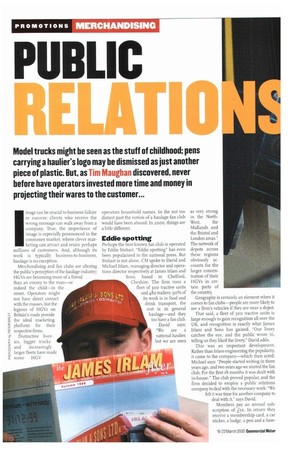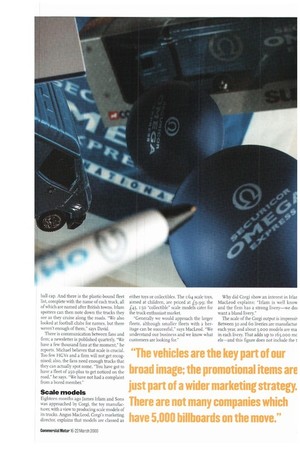PU [IC
Page 42

Page 43

Page 44

If you've noticed an error in this article please click here to report it so we can fix it.
Model trucks might be seen as the stuff of childhood; pens carrying a haulier's logo may be dismissed as just another piece of plastic. But, as Tim Maughan discovered, never before have operators invested more time and money in projecting their wares to the customer...
mage can be crucial to business failure or success: clients who receive the wrong message can walk away from a company. True, the importance of image is especially pronounced in the consumer market, where clever marketing can attract and retain perhaps millions of customers. And, although its work is typically business-to-business, haulage is no exception.
Merchandising and fan clubs are altering the public's perception of the haulage industry; HGVs are becoming more of a friend than an enemy to the man—or indeed the child—in the street. Operators might not have direct contact with the masses, but the legions of HGVs on Britain's roads provide the ideal marketing platform for their respective firms.
Distinctive liveries, bigger trucks and increasingly larger fleets have made some H G V operators household names. In the not too distant past the notion of a haulage fan club would have been absurd. In z000, things are a little different
Eddie spotting
Perhaps the best-known fan club is operated by Eddie Stobart. "Eddie spotting" has even been popularised in the national press. But Stobart is not alone. CM spoke to David and Michael Irlam, managing director and operations director respectively at James Irlam and Sons, based in Chelford, Cheshire. The firm runs a fleet of 300 tractive units and 480 trailers; 90% of its work is in food and drink transport, the rest is in general haulage—and they too have a fan club.
David says: "We are a national haulier, but we are seen as very strong in the North West, the Midlands and the Bristol and London areas." The network of depots across these regions obviously accounts for the larger concentration of their HGVs in certain parts of the country.
Geography is certainly an element when it comes to fan clubs—people are more likely to see a firm's vehicles if they are near a depot.
That said, a fleet of 300 tractive units is large enough to gain recognition all over the UK, and recognition is exactly what James Ham and Sons has gained. Our livery catches the eye, and the public wrote in, telling us they liked the livery," David adds.
This was an important development. Rather than Irlam engineering the popularity, it came to the company—which then acted. Michael says: "People started writing in three years ago, and two years ago we started the fan club. For the first 18 months it was dealt with in-house." The club proved popular, and the firm decided to employ a public relations company to deal with the necessary work. "We felt it was time for another company to deal with it." says David.
Members pay an annual subscription of Do. In return they receive a membership card, a car sticker, a badge, a pen and a base ball cap. And there is the plastic-bound fleet list, complete with the name of each truck, all of which are named after British towns. !dam spotters can then note down the trucks they see as they cruise along the roads. "We also looked at football clubs for names, but there weren't enough of them," says David.
There is communication between fans and firm; a newsletter is published quarterly. "We have a few thousand fans at the moment," he reports. Michael believes that scale is crucial. Too few HG Vs and a firm will not get recognised; also, the fans need enough trucks that they can actually spot some. "You have got to have a fleet of 250-plus to get noticed on the road," he says. "We have not had a complaint from a bored member."
Scale models
Eighteen months ago James Irlam and Sons was approached by Corgi, the toy manufacturer, with a view to producing scale models of its trucks. Angus MacLeod, Corgi's marketing director, explains that models are classed as either toys or collectibles. The 1:64 scale toys, aimed at children, are priced at £9.99; the p45, 1:50 "collectible" scale models cater for the truck enthusiast market.
"Generally we would approach the larger fleets, although smaller fleets with a heritage can be successful," says MacLeod. "We understand our business and we know what customers are looking for." Why did Corgi show an interest in I rlar MacLeod explains: "Irlam is well know and the firm has a strong livery—we doi want a bland livery."
The scale of the Corgi output is impressil Between 50 and Go liveries are manufactur each year, and about 3,000 models are ma in each livery. That adds up to 165,000 mc els—and this figure does not include the t
D range. For Corgi, the benefits of featuring Irlam and Sons is obvious: it makes a profit.
But the advantages for Idam, or any other haulier for that matter, are more difficult to define. "We make no money out of this at all; we generate money out of running trucks," says David Warn. The firm might not gain cash directly from the models and, as David and Michael report, no profit is made from the fan club either; but "from day one [the fan club] lifted the profile of the business", says Michael.
The bottom line is about projecting an image, and you simply cannot put a figure on that. Publicity is not restricted to appealing to the fan club member or model collector. Operators also strive to stick in the consciousness of their customers, again through merchandising.
To check out an effective example of this, CM visited the head office of fleet operator Securicor Omega Express. This is a big firm: it has 5,000 vehicles and 9,000 employees.
Its range of merchandise is big, too: teeshirts, model trucks and vans, stress balls, pens and carrier bags. These are all typical merchandising items but, as SOE marketing manager Mark Peacock explains, the firm spends money on them for a reason. For example, the UK team of too salesmen and women tend to leave the stress balls at customers' offices—or, of course, those of potential customers. Hassled employees squeeze the SOE stress ball. ..advertising could scarcely be more direct.
"The items can range from a couple of pounds up to £20 each," says Peacock. SOE has also given leather-bound Great Britain road atlases to too of its major customers. It is vital that merchandising, particularly when aimed at the customer, is of the right quality. If it's cheap and nasty it will be thrown out; if it's too attractive it's not likely to remain in an office. "If it is too fancy it will not stay where it is supposed to—on the desk," says Peacock.
Desired image
Ntcrchandising its place but, ultimately, the fleet itself is the most graphic way to project the desired image. Peacock says: "The vehicles are the key part of our broad image; the promotional items are just part of a wider marketing strategy. There are not many companies that have 5,000 billboards on the move." Still, merchandising has a role to play: "You have got to have something. If you don't, then you know for certain competitors will provide customers with something they really like."
It is not only the giants that provide gifts. Murray Hogg, a Newcastle-based haulier, runs
a fleet of 84 trucks. The firm invested in 250 calendars and 250 diaries for its customers. Managing director Murray Hogg has no doubt it's worth the effort; "It is about getting our name over to existing and prospective customers," he says.
A firm has to make a conscious decision to invest in merchandise, and project its image to both the customer and the public. This costs money. But unlike your typical investments—HGVs—the direct financial return on a complimentary calendar or pen is impossible to quantify.
Instead it is about spreading the word: increasing awareness of the firm; and that can pay dividends in the long run. And the process is straightforward. As David Irlam says, the production of merchandising and the running of fan clubs are not what you'd call rocket science.
















































































































